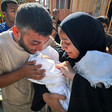Media Watch 18 May 2011
The above video taken last Sunday and uploaded today by Tania El Khoury, who also wrote a testimony about what happened during the march, shows images of Palestinian refugees in Lebanon chanting and attempting to reach the border with historic Palestine, and the Lebanese army pushing the protesters back.
AFP also put together a short video montage of images from the protest.
The Electronic Intifada published this moving account by Moe Ali Nayel of the historic march of tens of thousands of Palestinians and Lebanese to the border with historic Palestine.
Moe Ali Nayel wrote in his diary for EI:
My wife and I slowed our pace at one point to listen to an old Palestinian man leaning on a cane. He was walking with his grandson and telling him the story of the time he had had to leave Palestine and carry his nine-year-old sister while escaping to Lebanon over these very same mountains and paths. The old man spoke to his grandson of the beauty of Palestine and described how their home looked.Finally, as we gradually drew closer to the border, he told the young boy, “Soon you will go and see Palestine, the most beautiful country I have ever seen; it’s where we come from. It’s our land.”
But as pointed out earlier today by former Electronic Intifada editor Matthew Cassel — who took these striking photos of the march published by Al Jazeera English, and wrote this commentary for the Guardian’s Comment is Free — there has been scant coverage in the English-language corporate press of this historic event.
Approximately 40,000 persons participated in the march, commemorating the dispossession of historic Palestine with the establishment of the State of Israel in 1947-48. As Cassel observed, this is approximately ten percent of the total refugee population in Lebanon. The massive participation of Palestinian refugees is equivalent to 8 million Egyptians protesting at Cairo’s Tahrir Square, he wrote.
Jadaliyya published this account by Natalia Sancha, accompanied by photographs:
The Lebanese army does not interfere, neither does UNIFIL. Palestinians throw stones at the Lebanese army. Fire continues in the front. Shootings. We throw ourselves to the floor. We cannot run. We cannot move, there are mines all around us. The man two meters away from me is shot in the heart. The third “martyr.” Next to him, another man is shot in the leg. Out of desperation, one man takes one of the mines from the ground. We all start running. He wants to throw it at the Israeli soldiers. More shooting. A man shot in the cheek, another in the leg, another in the arm … it continues. The Lebanese army move all the Palestinians back, but they insist to keep going to the border. The girls push. The Lebanese army stop them. The men tell the army “don’t touch our women.” The girls start running, free, crazy, shouting “Palestine” towards the fence. “There are mines!!! Stop!!! Stop!!!”
Just as Palestinian refugees in Lebanon have been disenfranchised from the political process after Oslo, they have been disenfranchised in the media.






Comments
So what is Nakba really?
Permalink Adel Helal replied on
A lot of people I talk to (Arabs and non-Arabs) don't really understand what Nakba entails and why we protest every year, especially when history is told from the Western perspective.
The following article describes this catastrophe from our point of view:
http://hubofmiddleeastpolitics...
Let it be heard!